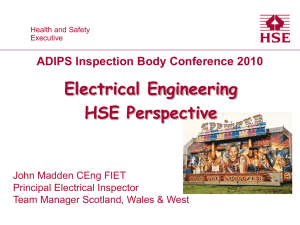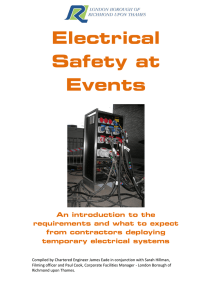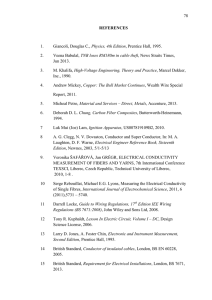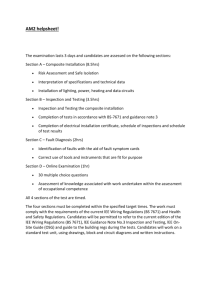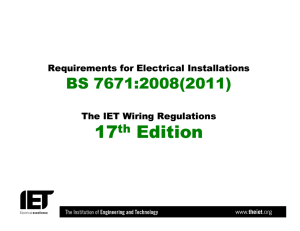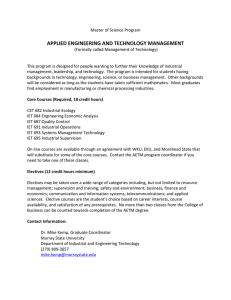Tempory power supplies
advertisement
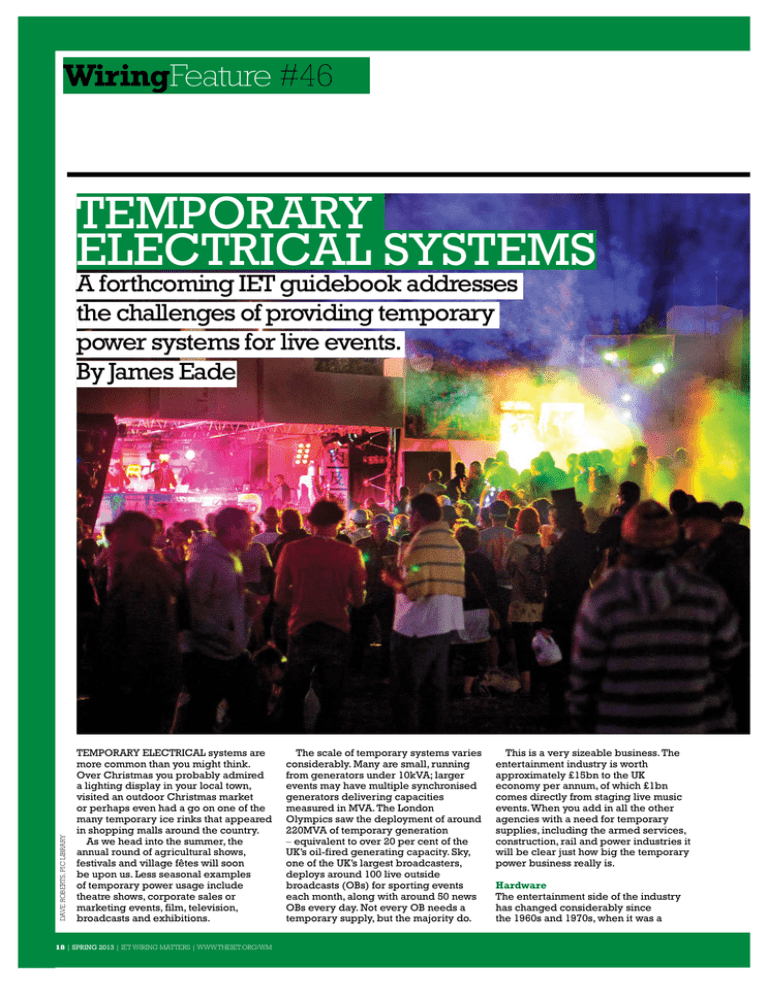
WiringFeature #46 Temporary electrical systems DAVE ROBERTS, PIC LIBRARY A forthcoming IET guidebook addresses the challenges of providing temporary power systems for live events. By James Eade Temporary electrical systems are more common than you might think. Over Christmas you probably admired a lighting display in your local town, visited an outdoor Christmas market or perhaps even had a go on one of the many temporary ice rinks that appeared in shopping malls around the country. As we head into the summer, the annual round of agricultural shows, festivals and village fêtes will soon be upon us. Less seasonal examples of temporary power usage include theatre shows, corporate sales or marketing events, film, television, broadcasts and exhibitions. 18 | SPRING 2013 | IET wiring matters | www.theiet.org/wm The scale of temporary systems varies considerably. Many are small, running from generators under 10kVA; larger events may have multiple synchronised generators delivering capacities measured in MVA. The London Olympics saw the deployment of around 220MVA of temporary generation – equivalent to over 20 per cent of the UK’s oil-fired generating capacity. Sky, one of the UK’s largest broadcasters, deploys around 100 live outside broadcasts (OBs) for sporting events each month, along with around 50 news OBs every day. Not every OB needs a temporary supply, but the majority do. This is a very sizeable business. The entertainment industry is worth approximately £15bn to the UK economy per annum, of which £1bn comes directly from staging live music events. When you add in all the other agencies with a need for temporary supplies, including the armed services, construction, rail and power industries it will be clear just how big the temporary power business really is. Hardware The entertainment side of the industry has changed considerably since the 1960s and 1970s, when it was a Fig 1: Example of electrical environments Zone 1 fledgling business. But, although the industry is now a much larger and more mature, the basic objectives remain the same: the rapid deployment of sufficient power to where it’s needed. In response to this goal, the industry has developed customised, ruggedised distribution units that can be quickly plugged together using cable and connector assemblies. However, while this ‘plug ‘n’ play’ approach using stock equipment offers real gains from a logistical perspective, and also has some safety benefits, too many installers have lost sight of the need to design and verify systems to ensure Zone 2 that protection against the risks of electric shock and fire is maintained in the haste to get systems assembled and operational. For example, it’s all too easy to fall into the trap of thinking that a 63A cable and connector assembly can safely deliver 63A to a connected load, with scant regard to its length or the characteristics of the supply to which it is connected. The typical time pressures of an event give rise to unique challenges. A band on tour could well have two or three 400A three-phase distribution systems, which, along with all the mains distribution, lighting, sound, video and other equipment, has to be unloaded from trucks, rigged and ready for the show within 3648 hours. After the final encore, everything will then be dismantled, packed and on the road to the next venue in an even shorter timescale. With thousands of gig-goers arriving at the door to see an event, no one is interested in delay notices, extras or similar constructionindustry-related issues. In response to this very demanding operating environment, the events industry has developed its own unique culture, along with the equipment and working practices that enable it to stage the same event reliably, time after time, in venues hundreds and sometimes thousands of miles apart. BS 7909 While protection is one area that is prone to being overlooked when assembling temporary power systems, it’s increasingly necessary to address the relatively new issues of power quality and EMC. In the past most loads were linear in nature, typified by tungsten lighting and amplifiers with linear supplies. Today however, nearly everything is driven by a switched-mode power supply if it isn’t already connected to a dimmer or variable-speed motor drive, giving rise to problems with Zone 3 Zone 4 harmonics, power factor, voltage quality and high leakage currents. The industry has also had to respond to environmental pressures. Recent research by the environmental group Green Festival Alliance shows that in 2011 UK festivals generated enough electricity to power 12,000 homes for a year, consuming 12 million litres of diesel and releasing 31,600t of CO2 into the atmosphere in the process. Not surprisingly, there have been attempts to introduce green energy to events, ranging from solar power to biodiesel and hydrogen fuel cells. However, integrating renewable energy sources into temporary power distribution systems demands careful planning. In response to these and other similar factors, BS 7909:2011 ‘Code of practice for temporary electrical systems for entertainment and related purposes’ was extensively revised and rewritten in 2008, and further updated in 2011 to reflect the changes in Amendment 1 of BS 7671:2008. As a code of practice, BS 7909 aims to provide guidance on the practical considerations for designing, deploying and managing a temporary system. But it still requires the reader to actually design a safe system in accordance with the fundamental principles of BS 7671. BS 7909 or BS 7671? The question of which standard to apply, and when, often arises. BS 7909 was largely written with the entertainment industry, including broadcast, film, theatre, outdoor events and touring in mind, and the terminology often reflects that fact. However, BS 7909 also represents a set of recommendations for the safe use and deployment of temporary electrical systems of any size or scope that use distribution equipment designed for the purpose – e.g. cables with plugs and sockets fitted, purpose-built portable distribution equipment and so on. As such, the scope of BS 7909 is wide; it gives recommendations for the management, > www.theiet.org/wm | IET wiring matters | SPRING 2013 | 19 KEY POINT HOW LONG IS ‘TEMPORARY’? Skid-mounted distribution unit with 400A three-phase in and through connections and a selection of 125A, 63A, 32A single and three-phase socket-outlets < design, setting-up and operation of temporary electrical systems for both entertainment and related industries, which include any events or activities using temporary electrical systems. A note in the scope refers to the fact that equipment used to form a temporary electrical system should be supplied as pre-assembled units that have been tested and are known to be safe and suitable for use. It doesn’t prohibit the manufacture on site of simple units that might be necessary, but it does consider this should be the exception rather than the rule. That note answers the question of which standard to apply. If a system plugs together without recourse to using tools to make terminations, then it falls within the scope of BS 7909. However, if a system (whether temporary or not) needs building, with wiring accessories having to be fitted, cables terminated and so on, then BS 7671 alone applies. It should be remembered that BS 7909 does require systems to be designed in accordance with BS 7671, but it does make provision for simplified testing based on the specific recommendations for equipment being followed. Further guidance on the symbiotic relationship between the two standards, and how to interpret the relevant regulations of BS 7671 and BS 7909 in order to achieve a safe temporary system, is given in the IET’s new guidebook, ‘Temporary Power Systems 20 | SPRING 2013 | IET WIRING MATTERS | WWW.THEIET.ORG/WM and Infrastructure for Entertainment’ – see panel on p22. BS 7671 Part 7 – special locations Some of the special locations in BS 7671 are relevant to the temporary power industry as a whole. Section 717 covers the electrical installations within mobile and transportable units, such as Portakabins, outside broadcast trucks, catering buses and accommodation units. It should be noted that Section 717 is not concerned with temporary electrical systems that may be connected to such units (except for the supply). Section 711 is concerned with exhibitions shows and stands, the scope of which is aimed at the type of exhibition or show that may be held within a purpose-designed venue, such as the Ideal Home Show. Theatrical-type shows or events are excluded in the scope of Section 711 as they come under the scope of BS 7909. Often the technical intent of a section will apply to a temporary system. For example, in the case of an outdoor ice rink consideration might be given to the requirements of Section 702, or for a festival with camping facilities Section 708 would be considered. The new IET guidebook gives guidance on those situations where the deployment of a temporary system may not necessarily need to (or be able to) follow all the requirements given in the appropriate Section of Part 7, but which should still BS 7671 makes no distinction between an electrical installation that is permanently fixed to a building structure and one that is not. It defines an electrical installation as “an assembly of associated electrical equipment having coordinated characteristics to fulfil a specific purpose”. It goes on to define a temporary electrical installation as an “electrical installation erected for a particular purpose and dismantled when no longer required for that purpose”. The key point to note is that despite being temporary, in BS 7671 it is still referred to as an ‘installation’. BS 7909 tries to make a distinction between permanent installations where equipment is permanently bolted to the building structure and temporary electrical distributions. Throughout the course of the lifetime of the temporary system it should perform effectively and safely. A Christmas lighting display would have a defined period of existence whereas a theatre show may have the planned run extended if it proves successful at the box office. There is no time limit that a temporary system may stay in existence but BS 7909 requires that the designer takes into account all the factors likely to affect the system for its original planned duration, with a date stated on the Completion Certificate at which a further assessment should be made to ensure the continued adequacy of the system. So a designer of a system used for a TV drama that is due to run for six weeks may state a reassessment date of eight weeks to allow for minor overrun, but give an indication that a proper review should be taken of the system if it is proving to be a popular show and the run is being extended accordingly. follow the technical intent – invariably concerned with minimising the enhanced risk of electric shock. Design considerations A quite different approach is required when designing a temporary system, compared to a fixed installation, and the IET guidebook describes the many areas that need considering, giving both worked and practical examples where necessary. For example, almost invariably temporary systems will be under the control of a skilled or instructed person, which may have implications for the design of circuit protection, or it might be outdoors exposed to the elements. In most cases selection of equipment is important as it needs to have the necessary resilience for repeated use as well as changing environmental factors. The use of armoured cables is rare because they are difficult to manhandle, not readily reuseable and do not have Class 5 Distribution units located under a stage flexible conductors. As such, mechanical protection of less robust cables has to be provided by other means, such as cable traps or positioning, and distribution connectors must be robust and suitable for repeated use. The electrical performance of a temporary distribution also needs careful planning. At an event the installation is often equivalent to ‘clipped direct’ (reference method C) and thermal insulation is uncommon. Instead, designers must allow for factors such as the warming of exposed cables by solar radiation. Also, many distribution units may be covered to keep off the rain and this may require MCBs to be de-rated if their ambient operating temperature exceeds 40°C. Another design factor often overlooked is that the current-carrying capacities and voltage drop tables in BS 7671 often need to be corrected for Class 5 flexible conductors depending on the cable type. If multicore cables are used (which are common for lighting circuit distribution) further correction factors should be applied depending on the load of each circuit in the multicore as well as the number of circuits. At larger events where significant quantities of power processing equipment such as switched-mode supplies, dimming or motor controls are used, consideration should also be given to power quality and residual currents as described earlier. Such equipment is a common source of harmonics, the triplens of which sum in the neutral of three-phase distributions, giving rise to high neutral currents – especially, and this is not uncommon, if the overall load is unbalanced. The use of EMI filtering in such equipment means high residual currents can be expected, which has implications for the specification of RCDs for circuit Learn protection and protection against electric shock. The new IET guidebook discusses how to correctly specify and use the different types of RCDs based on detection characteristics, operating currents, delay and load, as well as the common – and mostly erroneous – practice of bypassing them. And if that statement raised an eyebrow, then the book explains it all. Bonding and the environment Another design consideration that is often overlooked is the ‘electrical environment’ – a term defined in BS 7909 which is allied to, but not the same as, an equipotential zone. To understand the concept, consider a house with an electrical installation, as shown in Fig 1. The inside of the house with its electrical supply is one electrical environment, and if correctly wired is also likely to be an equipotential zone. The garden is a different electrical environment as it is at true Earth potential; not the potential of the supply earth at the main earth > Meet Discuss Network 30 APRIL - 2 MAY 2013 • EARLS COURT 2, LONDON 11th International Exhibition of Railway Equipment Systems & Services Harness the power of interaction Regis Now fo ter r free a t www .railtex. co.uk save £ 20 o the do n or • The Track • Education and Training • Project Update Theatre • The Platform • Networking • Innovation • The Yard • The Recruitment Wall • Hundreds of exhibitors • Thousands of products • Live demonstrations Further information: Email: info@railtex.co.uk Tel: +44 (0) 1727 814400 Media Partners www.railtex.co.uk Supporting Organisations WWW.THEIET.ORG/WM | IET WIRING MATTERS | SPRING 2013 | 21 James Eade, the author of ‘Temporary Power Systems and Infrastructure for Entertainment’, has worked in the events industry for over 20 years. He was formerly technical editor of the magazine Lighting&Sound International as well as chairman of the PLASA annual industry innovation awards panel. He currently provides industry training in temporary power systems as well as general design and management of event electrical services including those for event venues. Dimmer racks on the side of the stage at a music awards ceremony < terminal in the house (except for TT systems of course). The area around the street light in the road (which has its own supply distinct from that of the house) is another electrical environment. A vehicle in the street with an on-board generator encloses another electrical environment. BS 7671 does not specifically consider the interconnection of fixed installations derived from different supplies (save for some commentary in Section 444). In events, however, such interconnections are common. Generators are often used to provide additional power for a stage system located within a building which itself has its own supply, or at large events (such as Glastonbury, for example) multiple temporary distributions, each with its own generating plant, may reside together. More often than not the earthing systems will end up being interconnected, whether by mutual connection through exposed conductive parts (such as via lighting equipment mounted on a truss) or earth-referenced signal cables. In the event of a neutral failure on a TN-C-S building supply, for example, the earth electrode of a generator being used to supply power for an event inside the building may form the principal means of earthing through fortuitous connections between the temporary supply CPC and the building’s CPC. Even if no failure is present, the earth loops that can be created by such interconnections will invariably give rise to signal degradation, resulting in humming audio systems, jittery lights or scrolling ‘hum’ bars on video pictures. Taking supplies from an installation in a 22 | SPRING 2013 | IET WIRING MATTERS | WWW.THEIET.ORG/WM Example of a ‘keyed single-pole connector’ as defined in BS 7909 building to provide power for outdoor events presents similar safety issues that need to be considered. Testing The guidance given in BS 7909 is firmly rooted in the principle that equipment delivered to site has been checked for electrical safety, and can be shown to be safe and serviceable for use. It requires all the pre-manufactured cable assemblies and distribution equipment be tested in accordance with the IET Code of Practice for In-Service Inspection and Testing. The issue of testing temporary distributions is probably the most widely misunderstood aspect of the application of both BS 7909 and BS 7671. The new guidebook describes why testing is conducted and how to effectively and quickly test a temporary distribution. It also recommends testing intervals for portable equipment and items such as mobile and transportable units. In short, the book contains all you need to know to ensure a rigorous approach to testing within the timescale of a typical live event. * FACT FILE ABOUT THE BOOK The IET publication ‘Temporary Power Systems and Infrastructure for Entertainment’ deals with the correct application of the principles of BS 7671 and the application of BS 7909 to a temporary event. It is written in an accessible manner to assist readers with a range of skills and the wealth of information contained within its covers will be invaluable to students, technicians as well as practising electrical engineers. Its detailed chapters cover key topics including: ■ The relevant legislation, standards and industry guidance that apply to temporary events, including those relevant to permanent venues that may host temporary events such as exhibition halls or theatres. ■ Earthing arrangements including guidance on the identification and treatment of extraneousconductive-parts, supplementary bonding and protection methods. ■ Design principles and requirements including assessment, protective devices (especially the correct use of RCDs), load balancing, the effects of neutral loss, cable calculations, designing for power factor and harmonics, uninterruptible power supplies, emergency lighting and more. ■ Equipment provision and testing, including the supply of mobile and transportable units and correct specification of cable and connectors. It covers the relevant test requirements for portable equipment, suggests time intervals for the testing of equipment and explains the requirements of BS 7909 in respect of equipment supply. ■ The testing requirements of BS 7909 and how to achieve results in a timely manner on-site or when changing location. The potential hazards and problems associated with testing equipment such as dimmers, UPSs and RCDs as well as the additional requirements for special locations as defined in Part 7 of BS 7671 are considered. ■ Guidance on generators, street furniture and other supplies including operational considerations, methods of Earthing including earth electrode calculations, generator/supply interconnection and generator housekeeping. ■ Operational considerations including bypassing RCDs, safe working practices (including live working), protection of the temporary electrical distribution, emergency procedures and the relevant requirements of BS 7909. ■ Requirements for venues including provision of appropriate supplies and the requirements of BS 7909 with regard to exchange of information between visiting events and venue management.
